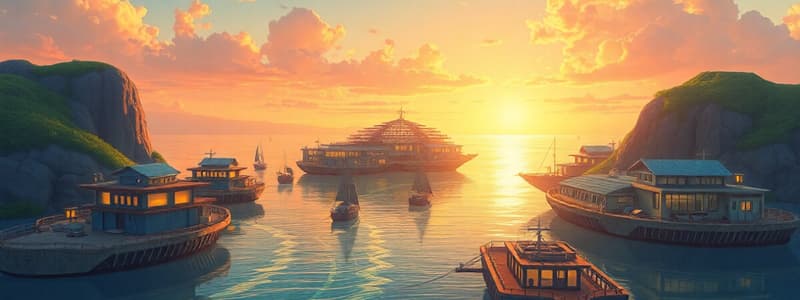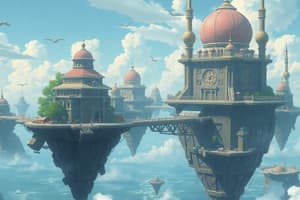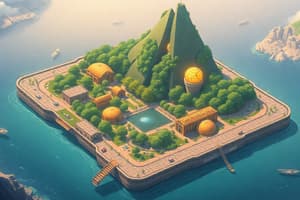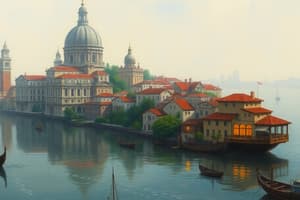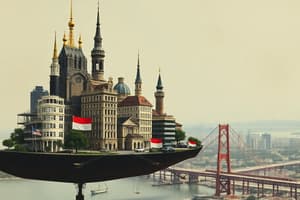Podcast
Questions and Answers
What unique food production capability does Dogen City utilize?
What unique food production capability does Dogen City utilize?
- Hydroponics using fresh water
- Seawater agriculture (correct)
- Aeroponic systems
- Soil-based agriculture
What is the target completion year for Dogen City?
What is the target completion year for Dogen City?
- 2025
- 2030 (correct)
- 2035
- 2040
Which of the following features is NOT mentioned as part of Dogen City's infrastructure?
Which of the following features is NOT mentioned as part of Dogen City's infrastructure?
- Hospitals
- Public transportation systems (correct)
- Schools
- Parks
How many people is Dogen City planned to accommodate, including residents and visitors?
How many people is Dogen City planned to accommodate, including residents and visitors?
What distinguishes Amsterdam's Schoonship neighborhood as a model for floating cities?
What distinguishes Amsterdam's Schoonship neighborhood as a model for floating cities?
What is the primary reason for building Dogen City?
What is the primary reason for building Dogen City?
What is a key feature of the undersea layer of Dogen City?
What is a key feature of the undersea layer of Dogen City?
How large is Dogen City in terms of diameter?
How large is Dogen City in terms of diameter?
What structural shape is Dogen City designed as?
What structural shape is Dogen City designed as?
By which year do experts predict that nearly 300 million people in coastal areas will face annual flooding?
By which year do experts predict that nearly 300 million people in coastal areas will face annual flooding?
Flashcards
N-Ark's Floating City
N-Ark's Floating City
A concept that proposes using a large, floating city to combat rising sea levels caused by global warming.
Dogen City
Dogen City
The name of the proposed floating city by N-Ark, designed to be circular with a diameter of 1 mile and a circumference of 2.5 miles.
Top Layer of Dogen City
Top Layer of Dogen City
The top layer of Dogen City, designed to be a self-sufficient city with residential and commercial areas.
Undersea Layer of Dogen City
Undersea Layer of Dogen City
Signup and view all the flashcards
Sea-Cooled Data Center
Sea-Cooled Data Center
Signup and view all the flashcards
What is Dogen City?
What is Dogen City?
Signup and view all the flashcards
What is the key aim of Dogen City?
What is the key aim of Dogen City?
Signup and view all the flashcards
How does Dogen City plan to ensure food security?
How does Dogen City plan to ensure food security?
Signup and view all the flashcards
What is Schoonship neighborhood?
What is Schoonship neighborhood?
Signup and view all the flashcards
What is the significance of Dogen City and Busan's projects?
What is the significance of Dogen City and Busan's projects?
Signup and view all the flashcards
Study Notes
Japan's Floating City Project
- Japan's N-Ark project plans a floating city called Doge City to combat rising sea levels.
- Doge City will be 1 mile (1.58 km) in diameter and 2.5 miles (4 km) in circumference.
- The city will protect inhabitants against tsunamis.
- The unique two-layer design will have an upper layer and a lower, underwater layer.
- The city will include a self-sufficient maritime city with features like a sea-cooled data center for city management, healthcare, and drug discovery.
- Doge City will house up to 10,000 residents and will have facilities, schools, sports areas, and parks.
- It will have a new farming sector producing 7,000 tons of food annually.
- The project's aim is to complete the construction by 2030
- Experts predict that nearly 300 million people living in coastal areas will face annual flooding by 2050
- Rising sea levels, fuelled by global warming, are escalating at an alarming rate, putting coastal communities worldwide at risk.
Studying That Suits You
Use AI to generate personalized quizzes and flashcards to suit your learning preferences.
